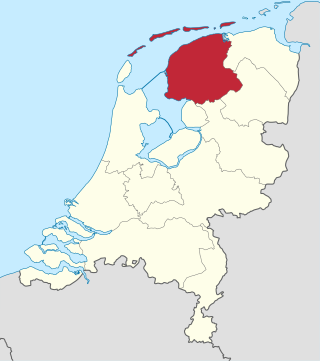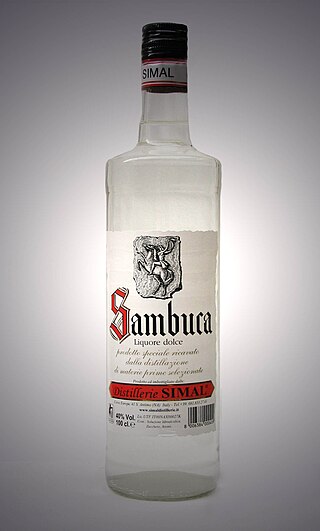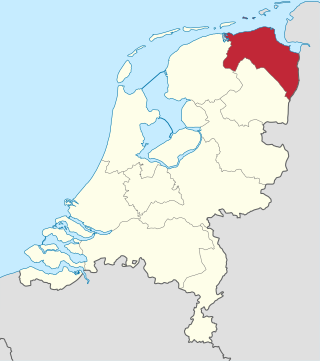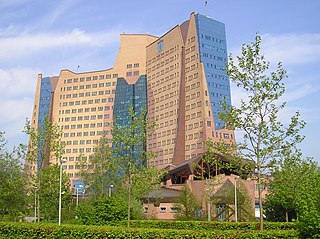
Friesland, historically and traditionally known as Frisia, named after the Frisians, is a province of the Netherlands located in the country's northern part. It is situated west of Groningen, northwest of Drenthe and Overijssel, north of Flevoland, northeast of North Holland, and south of the Wadden Sea. As of January 2023, the province had a population of about 660,000, and a total area of 5,753 km2 (2,221 sq mi).
The Frisians are an ethnic group indigenous to the coastal regions of the Netherlands, north-western Germany and southern Denmark, and during the Early Middle Ages in the north-western coastal zone of Flanders, Belgium. They inhabit an area known as Frisia and are concentrated in the Dutch provinces of Friesland and Groningen and, in Germany, East Frisia and North Frisia.

Sambuca is an Italian anise-flavoured liqueur. Its most common variety is often referred to as "white sambuca" to differentiate it from other varieties that are deep blue or bright red. Like other anise-flavoured liqueurs, the ouzo effect is sometimes observed when combined with water.

Leeuwarden is a city and municipality in Friesland, Netherlands, with a population of 127,073 (2023). It is the provincial capital and seat of the Provincial Council of Friesland.

Groningen is the northeasternmost province of the Netherlands. It borders on Friesland to the west, Drenthe to the south, the German state of Lower Saxony to the east, and the Wadden Sea to the north. As of January 2023, Groningen had a population of about 596,000, and a total area of 2,955 km2 (1,141 sq mi).

Groningen is the capital city and main municipality of Groningen province in the Netherlands. Dubbed the "capital of the north", Groningen is the largest place as well as the economic and cultural centre of the northern part of the country; as of December 2021, it had 235,287 inhabitants, making it the sixth largest city/municipality in the Netherlands and the second largest outside the Randstad.

The House of Orange-Nassau is the current reigning house of the Netherlands. A branch of the European House of Nassau, the house has played a central role in the politics and government of the Netherlands and elsewhere in Europe, particularly since William the Silent organised the Dutch Revolt against Spanish rule, which after the Eighty Years' War (1568–1648) led to an independent Dutch state. William III of Orange led the resistance of the Netherlands and Europe to Louis XIV of France and orchestrated the Glorious Revolution in England that established parliamentary rule. Similarly, Queen Wilhelmina of the Netherlands was instrumental in the Dutch resistance during World War II.

Frisia is a cross-border cultural region in Northwestern Europe. Stretching along the Wadden Sea, it encompasses the north of the Netherlands and parts of northwestern Germany. Wider definitions of "Frisia" may include the island of Rem and the other Danish Wadden Sea Islands. The region is traditionally inhabited by the Frisians, a West Germanic ethnic group.

Harlingen is a municipality and a city in the northern Netherlands, in the province of Friesland.

Sloe gin is a British red liqueur made with gin and blackthorn fruits (sloes), which are the drupe fruit of the Prunus spinosa tree, which is a relative of the plum. As an alcoholic drink, sloe gin contains between 15 per cent and 30 per cent alcohol by volume (ABV); however, European Union regulations established 25 per cent ABV as the minimal alcoholic content for the blackthorn beverage to be a sloe gin. Historically, despite being a liqueur based upon gin, the EU included the colloquial name sloe gin to the legal definitions; thus, sloe gin is the only alcoholic beverage that legally uses the term gin without appending the liqueur suffix.
Jagertee is an alcoholic punch historically made by mixing "Inländer-Rum" with spiced black tea. It is served warm and is typically consumed during winter in the cold parts of Central Europe.

Jenever, also known as Hollands, genever, genièvre, peket, or sometimes as Dutch gin, is the juniper-flavoured traditional liquor in the Netherlands, Belgium, and adjoining areas in northern France and northwestern Germany. As an EU and UK Protected Designation of Origin, the term jenever and its soundalikes can only be used if the product is made according to the specifications in Belgium, the Netherlands, two northern French departments, and two German federal states. Gin was developed in Britain after the introduction of jenever to the island.

Dutch cuisine is formed from the cooking traditions and practices of the Netherlands. The country's cuisine is shaped by its location on the fertile Rhine–Meuse–Scheldt delta at the North Sea, giving rise to fishing, farming, and overseas trade. Due to the availability of water and flat grassland, the Dutch diet contains many dairy products such as butter and cheese. The court of the Burgundian Netherlands enriched the cuisine of the elite in the Low Countries in the 15th and 16th century, so did in the 17th and 18th century colonial trade, when the Dutch ruled the spice trade, played a pivotal role in the global spread of coffee, and started the modern era of chocolate, by developing the Dutch process chocolate.

Liquor or distilled beverages are alcoholic drinks produced by the distillation of grains, fruits, vegetables, or sugar that have already gone through alcoholic fermentation. Other terms for liquor include spirit, spirituous liquor or hard liquor. While the word liquor ordinarily refers to distilled alcoholic spirits rather than beverages produced by fermentation alone, it can sometimes be used more broadly to refer to any alcoholic beverage.

Petrus Camper FRS, was a Dutch physician, anatomist, physiologist, midwife, zoologist, anthropologist, palaeontologist and a naturalist in the Age of Enlightenment. He was one of the first to take an interest in comparative anatomy, palaeontology, and the facial angle. He was among the first to mark out an "anthropology," which he distinguished from natural history. He studied the orangutan, the Javan rhinoceros, and the skull of a mosasaur, which he believed was a whale.

The Kingdom of the Netherlands, commonly known simply as the Netherlands, is a sovereign state consisting of a collection of constituent territories united under the monarch of the Netherlands, who functions as head of state. The realm is not a federation; it is a unitary monarchy with its largest subdivision, the eponymous Netherlands, predominantly located in Northwestern Europe and with several smaller island territories located in the Caribbean.

Squatting in the Netherlands is the occupation of unused or derelict buildings or land without the permission of the owner. The modern squatters movement began in the 1960s in the Netherlands. By the 1980s, it had become a powerful anarchist social movement which regularly came into conflict with the state, particularly in Amsterdam with the Vondelstraat and coronation riots.

The Ten Years were a period in the Eighty Years' War spanning the years 1588 to 1598. In this period of ten years, stadtholder Maurice of Nassau, the future prince of Orange and son of William "the Silent" of Orange, and his cousin William Louis, Count of Nassau-Dillenburg and stadtholder of Friesland as well as the English general Francis Vere, were able to turn the tide of the war against the Spanish Empire in favour of the Dutch Republic. They achieved many victories over the Spanish Army of Flanders, conquering large swathes of land in the north and east of the Habsburg Netherlands that were incorporated into the Republic and remained part of the Netherlands into the present. Starting with the important fortification of Bergen op Zoom (1588), Maurice and William Louis subsequently took Breda (1590), Zutphen, Deventer, Delfzijl, and Nijmegen (1591), Steenwijk, Coevorden (1592) Geertruidenberg (1593), Groningen (1594), Grol, Enschede, Ootmarsum, and Oldenzaal (1597)., recovering territories lost in 1580 through the treachery of George de Lalaing. Maurice's most successful years were 1591 and 1597, in which his campaigns resulted in the capture of numerous vital fortified cities, some of which were regarded as "impregnable". His novel military tactics earned him fame amongst the courts of Europe, and the borders of the present-day Netherlands were largely defined by the campaigns of Maurice of Orange during the Ten Years.
Anja Haga is a Dutch politician of the Christian Union (CU) who served as a Member of the European Parliament (MEP) between September 2023 and July 2024. Born in Drachten, she studied at the University of Groningen and subsequently became a clinical linguist. She switched to the private sector after a number of years, and by then she had become politically active. She lost in 2007 provincial elections in Friesland, but she did receive a seat in its council in 2010 to fill a vacancy. Haga was re-elected the following year and succeeded Piet Adema as parliamentary leader. She often commented on issues of public transport and sustainability, and she secured a third term in the provincial council in 2015 as her party's lead candidate.


















